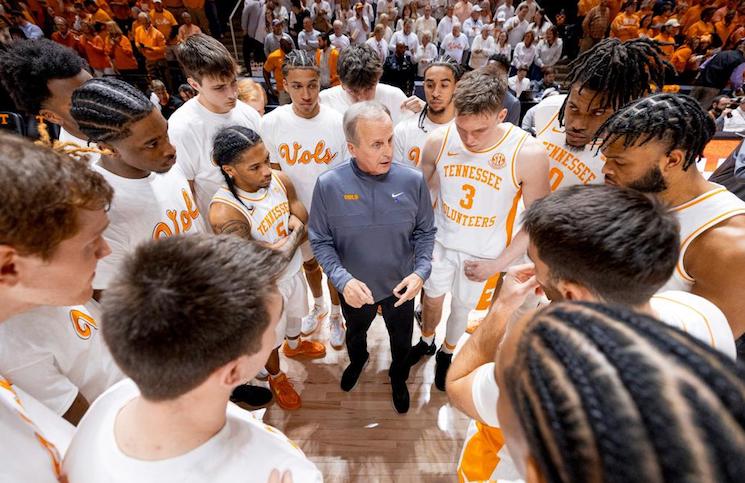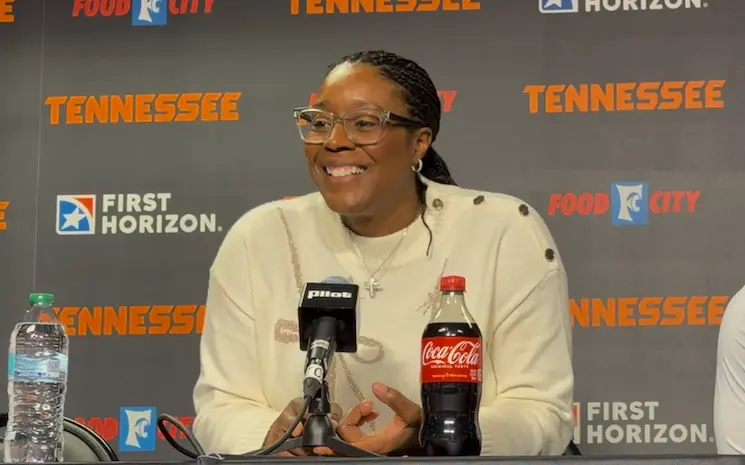
Tennessee’s men’s basketball program has never earned a one-seed in the NCAA Tournament. But this year’s UT team is poised to potentially finally earn one of the top four seeds in the Big Dance.
Even with the Vols losing 85-81 to Kentucky at home to end the regular season, they’re still projected by many bracketologists to be the fourth and final one-seed in this year’s NCAA Tournament. That’s thanks in large part to Arizona — Tennessee’s main competition for that final one-seed — losing by double digits on the road late Saturday night to a USC squad with a losing record.
Because of Arizona’s slip-up at arguably the worst time possible, the Vols are still expected to be one of the top four teams in the tournament. North Carolina is making a case thanks to a strong finish to the regular season that was capped off by an 84-79 win over No. 9 Duke on the road on Saturday night, but Tennessee’s tournament resume is giving them a slight edge over UNC by most projections.
If the Vols earn a one-seed, they won’t be playing close to home if they make a run, though. And that has fans debating the merits of being the fourth No. 1 seed versus earning the highest-rated spot among the two-seeds.
Tennessee would be placed in the West region of the bracket should they earn a berth as a one-seed, but they would likely end up in the East or South region if they were placed on the two-line. The first few rounds wouldn’t matter much, as UT could still play somewhere like Charlotte, North Carolina in the first two rounds even if they’re in the West region. However, the Sweet Sixteen and Elite Eight match-ups would be where geography starts to come into play, as the West regionals will be played all the way out in Los Angeles. The South regionals will be in Dallas, and the East regionals will be played in Boston.
So that begs the question: Is it better for the Vols to be the last one-seed in the tournament, or would their hopes of a deep run be better if they were the top two-seed in a more region-friendly bracket?
Ultimately, the draw of teams in your bracket matters more than location, and the NCAA Tournament is about as much of a crapshoot as any tournament spot in the world. However, we do have a good chunk of history to look back on, and this data may help Vol fans find an answer to this question.
So let’s get into it.
Deep Runs by One-Seeds vs. Two-Seeds Since 1985
Looking at the NCAA Tournament field in general, it’s much better to be a one-seed than any other seed if you hope to make a deep run. Since the tournament field expanded to 64 teams ins 1985, one-seeds have reached the Final Four 60 times, which is almost more than the total number of two, three, and four-seeds to go that far in that same timeframe.
Per BracketOdds, one-seeds have a 39.5% chance of reaching the Final Four based off NCAA Tournaments from 1985 through 2023. Two-seeds have the next-best odds, but they’re significantly less than one-seeds at only 21.1%. In fact, the chances of a two-seed making it to the Final Four are closer to the chances of a three-seed (11.2%) than a one-seed.
Looking at the Elite Eight — a place Tennessee has only gone once — just about two-thirds (66.4%) of all one-seeds in the NCAA Tournament since 1985 have reached that round. Not even half (44.7%) of two-seeds have advanced that far.
In fact, two-seeds have a weird propensity to struggle in the second round of the NCAA Tournament over the last 40 years. Two-seeds hold just a 67.4% win percentage in the Round of 32 since 1985, which isn’t that far off from the 61.5% win rate of a three-seed in the second round or the four-seed’s winning percentage of 60%.
One-seeds have won 85.3% of their second round games, for comparison.
No. 4 Overall or No. 5, Does it Matter?
But that doesn’t tell the whole story. Tennessee isn’t looking at just being a one-seed; they’re on the precipice of either being the “worst” one-seed or the “best” two-seed. So what does history say about how those respective seeds have performed in March?
I tried to find as much data as I could based on when the data became readily available on how the NCAA Tournament Selection Committee ranked each team on their seeding list. The data I could find went back to the 2012 NCAA Tournament, which gave me 11 tournaments’ worth of seed info to sift through (the 2020 Tournament was canceled due to COVID, so that’s why there’s only 11 tournaments instead of 12 between 2012-23).
So, what does the data say?
Over the last 11 NCAA Tournaments, the fourth one-seed has advanced to the national championship game twice, gone to the Elite Eight three times, and reached the Sweet Sixteen twice. So, in all, almost half of those particular one-seeds have gotten at least to the Elite Eight over the last 11 tournaments.
The No. 4 overall seed has also been bounced in the second round on three occasions, and the most recent No. 4 overall seed just became the second one-seed EVER to lose in the 1st round, when Purdue fell to 16-seed Fairleigh Dickinson by a score of 63-58 last year.
Does that mean it’s more advantageous to be the top-rated two-seed?
Not quite.
To start, let’s look at where the “best” two-seed usually ends up in the bracket. The No. 5 overall seed, a.k.a. the highest-rated two-seed, isn’t always placed in the same bracket as the lowest-rated one-seed. In fact, they’ve most often been placed in the same bracket as the No. 3 overall seed, with that paring occurring six times over the last 11 tournaments compared to the top two-seed being in the same bracket as the No. 4 overall seed just three times.
Not that it’s mattered much, though. The highest-rated two-seed has failed to reach the Elite Eight nine out of the last 11 tournaments. So most of those two-seeds haven’t even had a chance to play the one-seed in their bracket over the last decade-plus.
No. 5 overall seed Kansas made it all the way to title game in 2012 before losing to one-seed Kentucky. The only other top-rated two-seed to even make it to the Regional Final round of the tournament over the last 12 years was, oddly enough, Kentucky. The Wildcats advanced to the Elite Eight in 2017 before losing to one-seed North Carolina — the No. 3 overall seed in that tournament.
The highest-rated two-seed has advanced to the Sweet Sixteen in three of the last four tournaments, and they’ve reached that level four times total in the last 11 tournaments. But reaching the Sweet Sixteen this year won’t be adequate enough for UT, not based off their metrics and the expectations placed on them. So getting that far as the top two-seed only to fall short of another Elite Eight won’t cut it, but that’s been the most common outcome for the No. 5 overall seed the last four tournaments.
Interestingly, Tennessee is one of those top-rated two-seeds to reach the Sweet Sixteen previously, as the Vols got to that point in 2019 before losing to three-seed Purdue. So Tennessee has seen this film before, and I don’t think anyone would like that particular ending this year.
The top-rated two seed has fallen in the second round four times in the last 11 tournaments, and they also have a first round exit. Back in 2016, No. 5 overall seed Michigan State was stunned by 15-seed MTSU in the opening round of the tournament.
In short, the 4th overall one-seed has made it to two national title games and has gotten at least to the Elite Eight five out of 11 times since 2012. In that same timeframe, the top-rated two-seed has advanced as far as the Elite Eight just twice.
Rick Barnes and One-Seeds
If you’re a believer in history repeating itself, then you definitely want Tennessee to get a one-seed this year.
Rick Barnes has led a team to the NCAA Tournament 27 times, but his teams have only earned a one-seed once. That team just so happens to be the only team Barnes has taken to the Final Four.
The 2002-03 Texas Longhorns earned a one-seed after a 22-5 regular season and despite losing their one and only game in the Big 12 Tournament. That lackluster ending in their conference tournament wasn’t a sign of things to come, however, as Texas crushed UNC Asheville, took down Purdue, knocked out UConn, and beat Michigan State to reach the program’s first Final Four since 1947.
It’s extremely difficult to take multiple teams to the Final Four. In fact, only 17 Division 1 men’s basketball coaches have ever done so, with Jim Larranaga (2023) and Kelvin Sampson (2021) being the two most recent coaches to join that select group.
But if Barnes wants to become the 18th coach to take multiple schools to the Final Four, it’s best to have as many odds in your favor as you can. And history has proven that a one-seed, no matter which of the four it is, has a better chance of making a deep tournament run than any two-seed.



